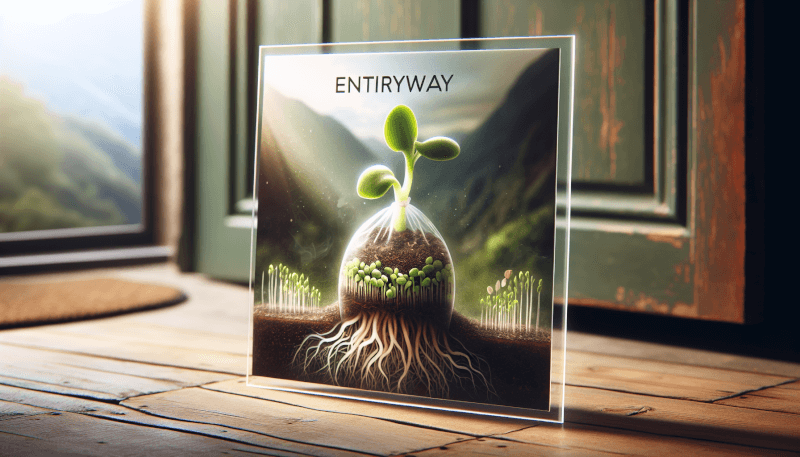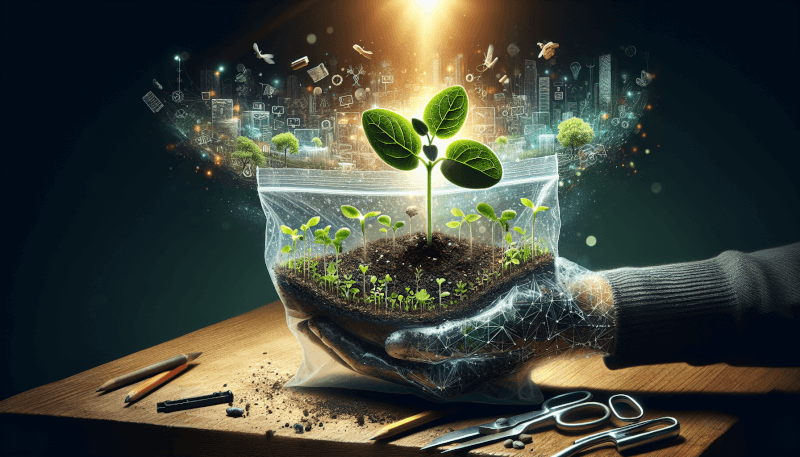👋 Click the mic button to talk to Alfred, the Todd's Seeds Gardening/Sprouting Expert – Feel free to ask him anything!
Ask Virtual Todd Anything - Click the Mic
Imagine a world where you can grow your own fresh and delicious vegetables without the need for a traditional garden. Well, with the innovative technique of sprouting seeds in plastic bags, you can do just that! This method, gaining popularity among both seasoned and aspiring gardeners, offers a simple and convenient way to foster the growth of seeds indoors all year round. Say goodbye to limited space and unpredictable weather – it’s time to embrace this exciting way of cultivating your own greens.
Choosing the Right Seeds
When it comes to sprouting seeds in plastic bags, selecting the right seed varieties is crucial for success. Not all seeds are suitable for sprouting, so it’s important to choose those specifically labeled for sprouting or ones known to have a high sprouting success rate. Popular options include alfalfa, mung beans, broccoli, and radish seeds. Consider your preferences and dietary needs when deciding on seed varieties.
Checking Seed Viability
Before embarking on your sprouting journey, it’s essential to check the viability of your seeds. This ensures that they are capable of germination and will yield healthy sprouts. To perform a simple viability test, take a small sample of seeds and place them on a damp paper towel. Keep them in a warm, dark place for a few days and observe if they sprout. If the majority of the seeds show signs of sprouting, they are viable and ready to use.

Deciding on Seed Quantity
The amount of seeds you should sow depends on your sprouting needs and available space. It’s recommended to start with small batches until you gain confidence and experience in the sprouting process. A general rule of thumb is to use approximately one tablespoon of seeds per quart-sized plastic bag. If you prefer a larger yield, adjust the quantities accordingly. Remember that sprouting seeds expand in volume as they germinate, so leave enough room for growth within the bag.
Preparing Supplies
To ensure a smooth and successful sprouting experience, gather all the necessary supplies before you start. You will need quart-sized plastic bags, preferably with zip-lock tops for convenience. Additionally, get your hands on high-quality organic potting soil or a sprouting mix designed for bag sprouting. Having all your supplies ready in advance will save you time and make the process more enjoyable.

Cleaning Plastic Bags
Before using plastic bags for sprouting, it’s crucial to clean them thoroughly to remove any dirt or contaminants. Wash the bags with warm soapy water and rinse them well. Alternatively, you can sanitize the bags by dipping them in a solution of water and food-grade hydrogen peroxide. Allow the bags to air dry completely before proceeding with the sprouting process.
Creating Drainage Holes
Plastic bags need proper drainage to prevent excess moisture from accumulating and potentially causing mold or root rot. Using a sharp object like a fork or a needle, poke several small holes at the bottom of each plastic bag. These holes allow excess water to drain out, ensuring the sprouts receive the right amount of moisture to thrive.

Soaking Seeds
Before planting the seeds in the plastic bags, it’s beneficial to soak them. Soaking seeds in water helps to jump-start the germination process and reduces the time it takes for sprouts to appear. Place the seeds in a bowl or container and cover them with water. Follow the seed packet instructions for the recommended soaking time, typically ranging from 4 to 12 hours. Once the soaking time is complete, drain the water and proceed with rinsing the seeds.
Rinsing and Draining Seeds
After soaking, rinse the seeds thoroughly under running water. This step helps to remove any residual compounds from the seeds and prevents the growth of harmful bacteria. Place the rinsed seeds in a colander or strainer to drain excess water. It’s crucial to ensure the seeds are no longer dripping before transferring them to the plastic bags for planting.

Planting in Plastic Bags
Now that your seeds are prepared, it’s time to plant them in the plastic bags. Follow these steps to ensure optimal growth and sprouting success.
Filling Bags with Soil
Fill each plastic bag with approximately 1 to 2 inches of moistened potting soil or sprouting mix. Ensure the soil is evenly spread across the bottom of the bag, providing a solid foundation for the seeds.
Sowing Seeds
Evenly distribute the pre-soaked and drained seeds on top of the soil in each bag. Spread them out to avoid overcrowding, which can impede sprout growth. Gently press the seeds into the soil, making sure they are in contact with the moistened surface.
Moistening the Soil
After sowing the seeds, moisten the soil in each bag using a gentle spray of water. Be careful not to create excessive pooling or overly saturated conditions. The goal is to provide enough moisture to support sprout growth without drowning the seeds. Regularly monitor the soil’s moisture levels throughout the sprouting process and adjust as necessary.
Caring for Sprouts
Sprouts require proper care to ensure healthy growth and development. Pay attention to the following factors to provide the optimal environment for your sprouts.
Light and Temperature
Place the plastic bags in a location that receives indirect sunlight or partial shade. Avoid exposing the sprouts to direct sunlight, as it can lead to excessive heat and drying out of the soil. Maintain a stable temperature between 60 and 75 degrees Fahrenheit (15-24 degrees Celsius) to promote optimal sprout growth.
Maintaining Moisture
Moisture is crucial for sprout growth, so it’s essential to monitor and maintain appropriate moisture levels. Check the soil regularly and mist it with water as needed. Be cautious not to overwater, as excessive moisture can lead to mold growth. A balance between moist and well-drained soil is key to healthy sprouts.
Providing Ventilation
Good ventilation is essential for preventing mold and maintaining healthy sprouts. While the plastic bags provide a controlled environment, it’s important to open them periodically to allow fresh air circulation. This can be done by partially unzipping or loosening the bag’s top closure. Avoid prolonged exposure to open air, as it can cause the sprouts to dry out.

Monitoring Growth
To ensure the successful growth of your sprouts, you need to monitor their progress closely. By observing and recording growth milestones, you can identify any issues and make adjustments as needed.
Daily Observation
Take a few moments each day to carefully inspect the sprouts. Look for signs of mold, discoloration, or any unusual growth patterns. Monitor the sprouts’ overall health and note any changes in their appearance. Keeping a daily observation log will help you track the progress and recognize any potential problems early on.
Recording Growth Progress
To accurately track growth, measure the sprouts’ height or length regularly. Use a ruler or measuring tape to measure the tallest sprout in each bag. Recording this information in a journal or spreadsheet will allow you to assess the growth rate and compare it to the recommended timeframes for each seed variety.
Avoiding Common Issues
While sprouting seeds in plastic bags is relatively easy, a few common issues can arise. By taking proactive measures, you can prevent and address these problems effectively.
Preventing Mold and Mildew
Mold and mildew can quickly develop in excessively damp conditions, leading to unhealthy sprouts. To prevent mold growth, ensure proper ventilation and avoid overwatering the sprouts. If you notice any signs of mold or mildew, carefully remove the affected sprouts and adjust the moisture levels accordingly.
Dealing with Pest Infestations
While less common, pests like gnats and fruit flies can be a nuisance and potentially harm your sprouts. To deter pests, ensure good hygiene by keeping the surrounding area clean and removing any decaying organic matter. If necessary, gently wipe the outside of the bags with a mild vinegar solution to discourage pests.
Harvesting and Using Sprouts
Once your sprouts have reached their desired stage of growth, it’s time to harvest and enjoy the fruits of your labor.
Determining Sprout Readiness
Most seeds will produce sprouts ready for harvest within 3 to 10 days, depending on the variety. Look for fully developed cotyledons (seed leaves) and vibrant coloration as indicators of readiness. Taste tests can also help determine the optimal harvest time, as some people prefer sprouts at different stages of growth.
Harvesting Sprouts
To harvest the sprouts, gently remove them from the plastic bags by grasping the base of each sprout and pulling upwards. Rinse the sprouts under cool running water to remove any residual soil or loose seed shells. Pat them dry with a clean cloth or paper towel before transferring to a storage container.
Enjoying Fresh Sprouts
Fresh sprouts can add a nutritious and flavorful touch to a variety of dishes. Incorporate them into salads, sandwiches, wraps, stir-fries, or enjoy them as a healthy snack on their own. Store any leftovers in a sealed container in the refrigerator, where they can stay fresh for up to a week.
Expanding Your Sprouting Endeavors
Once you’ve mastered the art of sprouting seeds in plastic bags, there are endless possibilities to explore.
Exploring Other Sprouting Methods
While plastic bag sprouting is convenient and accessible, you can also delve into other sprouting methods. Consider trying jar sprouting, tray sprouting, or using specialized sprouting equipment. Each method has its advantages and can offer a unique sprouting experience.
Trying Different Seed Varieties
Expand your horizons by exploring different seed varieties and experimenting with new flavors and textures. There is a vast array of sproutable seeds available, ranging from legumes to grains and even herbs. Discover the wide range of options and find your new favorite sprouts.
Conclusion
Sprouting seeds in plastic bags is a simple and rewarding way to enjoy homegrown sprouts. By choosing the right seeds, preparing supplies effectively, and providing proper care, you can experience the joy of harvesting fresh sprouts from the comfort of your own home. Whether you stick with the tried-and-true seed varieties or venture into new sprouting methods, the benefits of sprouting in plastic bags are abundant. So grab your seeds, gather your supplies, and embark on a sprouting journey that will delight your taste buds and nourish your body. Enjoy your homegrown sprouts!